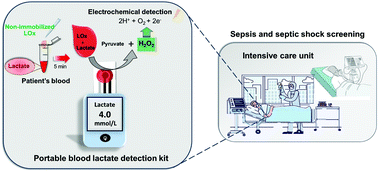A portable blood lactate sensor with a non-immobilized enzyme for early sepsis diagnosis†
Abstract
Early determination of blood lactate levels may accelerate the detection of sepsis, one of the most time-sensitive illnesses. We developed and validated a portable blood lactate detection kit for clinical screening that can measure early bedside lactate levels in intensive care unit (ICU) patients suspected of having sepsis. A TiO2 sol–G nanocomposite was prepared and coated on a screen-printed carbon electrode (SPCE) integrated with non-immobilized lactate oxidase (LOx) to produce a novel lactate biosensor with high sensitivity and high storage stability for human blood lactate measurement. The detection kit was based on an electrochemical technique and showed a wide linear range of 1–20 mM (R2 = 0.9937) with a low detection limit of 0.2 mM for lactate detection. This allowed for differentiating patient groups who may have sepsis using a cut-off level of 4 mM. The device was successfully implemented for blood lactate determination in critical patients, showing an accuracy range from 75% to 112%. This device provided high-precision and rapid quantitative information validated using a blood gas analyzer. Our detection kit might help to reduce the morbidity and mortality rates in severe sepsis and septic shock patients in community hospitals.

- This article is part of the themed collection: 150th Anniversary Collection: Sensors for Human and Planetary Health


 Please wait while we load your content...
Please wait while we load your content...